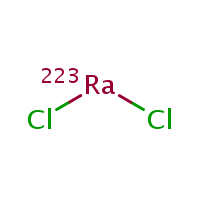Radium 223 Dichloride

Xofigo (radium-223 dichloride) is used to treat certain men with advanced prostate cancer. It is intended for men whose cancer has spread (metastasized) only to their bones and who have already received treatment to lower testosterone. Because testosterone can cause prostate cancer to grow, the goal of some surgery and drug treatments is to lower the level of this male hormone in the body. When the cancer spreads or comes back after such treatment, it’s sometimes called castration-resistant. Xofigo is a type of radiopharmaceutical. Radiopharmaceuticals are radioactive drugs. Radiopharmaceuticals are used in the field of nuclear medicine as radioactive tracers in the diagnosis and treatment of many diseases. A radioactive tracer is a chemical compound with an attached radioactive isotope [a variant of a chemical element] that can be introduced into and tracked within the body.Through a complex process, these radioactive isotopes undergo radioactive decay, resulting in the emission of particles such as alpha or beta particles. Radioactive isotopes are used primarily either for their chemical properties or as a source of radiation. Radionuclides of similiar elements can serve as radioactive tracers because they are similar chemically to the non-radioactive elements.There are some radionuclides that are bone seeking radioisotopes and those radionuclides exhibit chemical behavior similar to calcium, allowing them to be absorbed in areas where cancer is present in the bone. Once in the bone, the radioisotope emits beta or alpha particles, which kill the nearby cancer cells.
How Xofigo Is Given:
-
Xofigois given through a vein (intravenously, IV), as a slow [intravenous] injection, over about 1 minute.
-
There is no pill form of Xofigo.
-
It is given in a clinic or facility where healthcare providers or technicians have been trained to give radiation therapy.
-
It is given once every 4 weeks for a maximum of 6 doses.
The active moiety of Xofigo is the alpha particle-emitting isotope radium-223 (as radium Ra 223 dichloride), which mimics calcium and forms complexes with the bone mineral hydroxyapatite at areas of increased bone turnover, such as bone metastases. The high linear energy transfer of alpha emitters (80 keV/micrometer) leads to a high frequency of double-strand DNA breaks in adjacent cells, resulting in an anti-tumor effect on bone metastases. The alpha particle range from radium-223 dichloride is less than 100 micrometers (less than 10 cell diameters) which limits damage to the surrounding normal tissue.
The following side effects are common (occurring in greater than 10%) for patients taking Xofigo:
-
Nausea
-
Vomiting
-
Diarrhea
-
Swelling of the lower legs and hands [peripheral edema]
-
Low blood counts. Your white and red blood cells and platelet counts may temporarily decrease. This can put you at increased risk for infection, anemia and/or bleeding.
These are less common (occurring in 1-5%) side effects for patients receiving Xofigo:
-
Dehydration
-
Injection site reactions (redness, pain, swelling)
-
Kidney failure / impairment
Not all side effects are listed above. You should always inform your health care provider if you experience any unusual symptoms.
